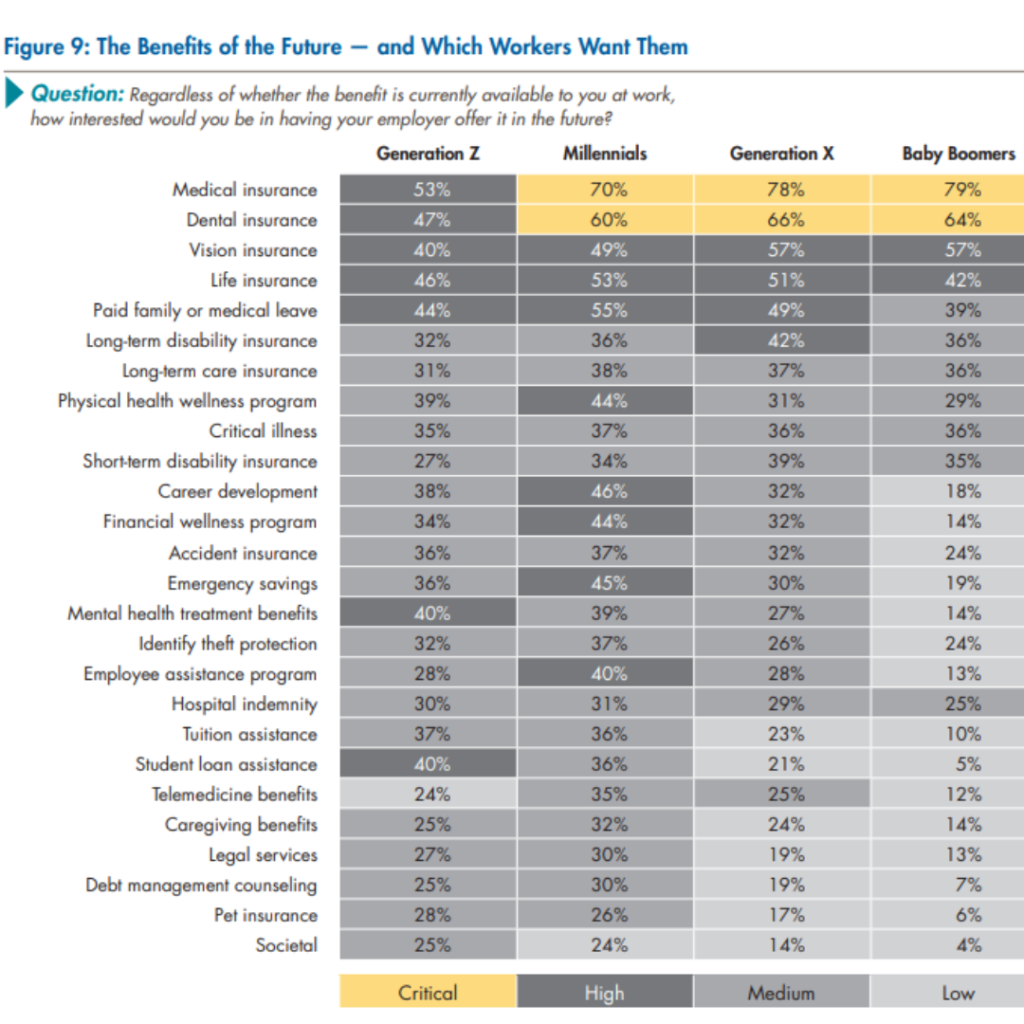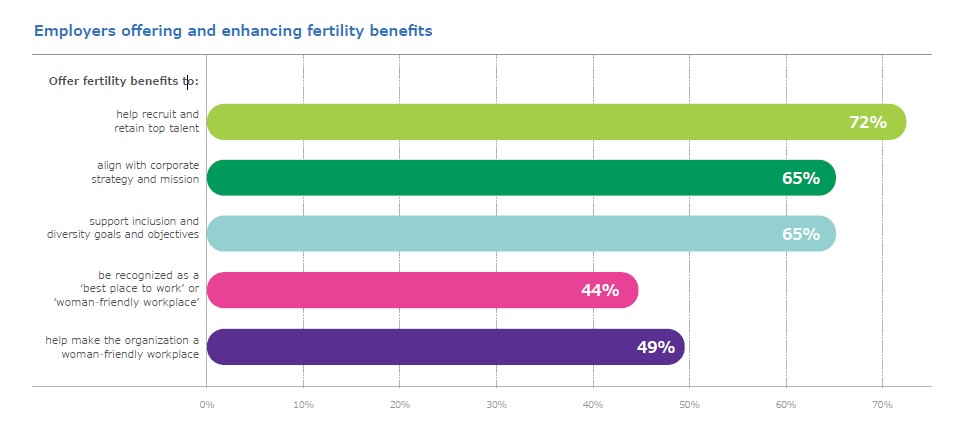Modern employees continue to place a high value on benefits in a post-pandemic society, and they are willing for even more choices. Nontraditional offers that were once considered afterthoughts are now crucial to organizations’ value propositions, especially given today’s fierce competition for talent.
The LIMRA-EY 2023 Workforce Benefits Study confirms that flexible and holistic strategies are key for employers looking to meet the needs of a diversifying workforce, compete for talent and maximize their return on benefits investments.
Workers’ value of benefits remains high in a post-pandemic world, and they are now looking for even more options. Nontraditional offerings that would have been afterthoughts a decade ago are now central to employers’ value proposition, especially given today’s intense competition for talent. The pandemic further accelerated this trend, with employees looking for more benefits related to physical, financial, and mental wellness delivered in a more contemporary (i.e., digital) way.

These findings demonstrate how benefit plans primarily developed for Baby Boomers and Generation X do not always satisfy the demands of Millennials and Generation Z. Employers will need to change their benefits packages and delivery approaches to meet their talent demands today and tomorrow, as workforces are increasingly made up of these younger generations.
The modern workplace is shifting fertility coverage
Defining infertility
Infertility means a disease, condition, or status characterized by:
1. A failure to establish a pregnancy or to carry a pregnancy to live birth after
regular, unprotected sexual intercourse; or
2. A person’s inability to reproduce either as a single individual or with their partner
without medical intervention; or
3. A licensed physician’s findings based on a patient’s medical, sexual and
reproductive history, age, physical findings, and/or diagnostic testing; or
4. A disability as an impairment of reproductive function.
According to a new World Health Organization (WHO) report issued in 2023, infertility affects a large percentage of people throughout their lives. WHO’s position is that Infertility affects around 17.5% of the adult population, or roughly one in every six people worldwide, highlighting the critical need to provide access to inexpensive, high-quality fertility care for those in need. Infertility affects roughly 13% of women between the ages of 15 and 49.

As the number of people seeking fertility care and IVF increases, the need for fertility assistance and support also increases.
Fertility treatment
Fertility treatment begins with identifying the cause of reproductive issues and diagnosing infertility. General risk factors of infertility for both men and women include age, body weight, smoking, or alcohol consumption. Some risk factors appear as clinical conditions, such as ovulatory disorders or uterine or cervical abnormalities in women and testicular and other medical conditions in men.
Some causes can be addressed with simple lifestyle changes. In other cases, infertility may be
treated with surgery, medication, IUI, assisted reproductive technology (ART), or a combination of approaches.
MORE EMPLOYERS ARE OFFERING EVIDENCE –BASED FERTILITY BENEFITS
According to a Willis Towers Watson survey of 479 employers with at least 100 employees, as of 2020, almost three-quarters (72%) of employers cite the competitive pressure to attract and retain talent as the primary reason to offer fertility benefits, but other reasons influence the decision to offer benefits as well.
(https://www.wtwco.com/en-us/insights/2020/05/employers-prioritize-family-friendly-benefits)
Almost two-thirds of employers (65%) say they offer family-friendly benefits because they relate with their company strategy and vision, and an equivalent percentage says they do so to support their organization’s inclusion and diversity goals and objectives.
As of October 1, 2019, Starbucks announced that both full- and part-time employees would be reimbursed for surrogacy, intrauterine insemination (IUI), and IVF. Lifetime maximums
for fertility benefits will also be increased.
Walmart employees are now eligible to receive $20,000 in financial support towards surrogacy and adoption related needs. Last November, its HR spearheaded a deal with the fertility clinic, Kindbody, to increase employee access to IVF, genetic testing and fertility assessments. There are 30 such clinics across the USA and since the partnership’s launch; over 1,300 employees have utilized clinic’s services.

COMMON TREATMENT OPTIONS FOR INFERTILITY
The most common treatments than could be included in an employee benefit or insurance plan are Surgery, Medication, IUI and IVF. Coverage for in vitro fertilization (IVF) has grown rapidly over the past few years. In 2022, 43% of large employers covered IVF, up from just 27% in 2020. Nearly two-thirds of organizations that provide fertility benefits do not require members to have a diagnosis of infertility to be eligible for coverage, which means that same-sex couples and single intending parents may access coverage.
A comprehensive fertility preservation benefit can help with a variety of corporate performance measures that affect the bottom line, like as attraction and retention. If benefits complement their specific family-building aspirations, candidates may be more drawn to a company, and existing employees may be more likely to stay. Solutions that provide fertility preservation benefits can also assist maintain productivity by minimizing time spent researching treatments and supporting family members through the process; they can help lessen stress connected with family building within a certain timeline. Furthermore, providing this benefit could point out company values.

Cost impact of offering infertility coverage
There is a common concern that by adding a fertility coverage benefit to a health care benefits package will increase health care costs for an employer. However, according to a 2021 employer survey conducted by consulting firm Mercer, and commissioned by RESOLVE (National Infertility Association): 97% of respondents offering infertility treatment have not experienced an increase in their medical costs because of providing this coverage. In addition, covered employees were less likely to miss time from work due to treatments, psychological stress, depression or other conditions related to infertility; were more likely to recommend their employer as a place to work; and felt their employer listened and met their needs and cared about their well-being.
Conclusion
New needs, evolving expectations, and sustained competition for scarce talent will drive steady and significant increases in the demand for workforce benefits. Nonmedical benefits will only become more important and will soon be viewed as baseline must-haves for workers evaluating different organizations and their work options.
Certainly, employers are looking to distinguish themselves with more family-friendly and inclusive benefit offerings.
The birth rate among women over 40 has been increasing as more working women delay having children, and fertility benefits have been shown to influence their employment decisions. When coverage is not restricted to women and men in a heterosexual relationship, these benefits can also make an organization more attractive to LGBTQ+ employees. And the good news for employers considering adding or enhancing their fertility benefits is that did so without experiencing any significant increase in medical plan cost.
(https://resolve.org/wp-content/uploads/2022/01/2021-Fertility-Survey-Report-Final.pdf )